Discover 11 hidden attractions, cool sights, and unusual things to do in Paris (United States). Don't miss out on these must-see attractions: Paris First, Logan County Courthouse, and Smith Hospital. Also, be sure to include Methodist Episcopal Church in your itinerary.
Below, you can find the list of the most amazing places you should visit in Paris (Arkansas).
Table of Contents
Paris First

Church in Paris, Arkansas. The First Christian Church is a historic church at 120 East Walnut Street in Paris, Arkansas. It is a T-shaped single-story building, constructed out of stone and concrete between 1930 and 1936 for a congregation of the Disciples of Christ organized about 1890. It is the congregation's second church, the first having been severely damaged by a storm in 1929. It is locally distinctive for its architecture, a basically Collegiate Gothic form with Romanesque details.
The building was listed on the National Register of Historic Places in 1995.[1]
Address: 311 E Main St, Paris
Logan County Courthouse
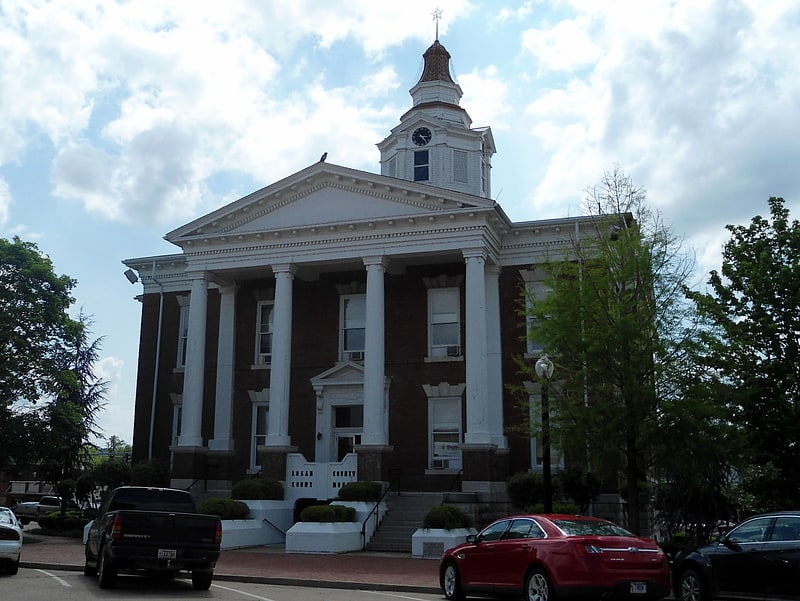
Courthouse. The Logan County Courthouse, Eastern District is located at Courthouse Square in the center of Paris, one of two county seats for Logan County, Arkansas. It is a handsome two story Classical Revival building, built out of brick and set on a foundation of cut stone. It has classical temple porticos on three sides, and is topped by an octagonal tower with clock and belfry. It was built in 1908, and is one of the city's most architecturally imposing buildings.
The building was listed on the National Register of Historic Places in 1976.[2]
Address: 25 W Walnut St, 72855-3845 Paris
Smith Hospital

Hospital in Paris, Arkansas. Smith Hospital is a former medical facility in Paris, Arkansas, located at the northern end of Express Street. Built in 1913 and enlarged in 1926, it was the first hospital in Logan County. It consists of an original two-story brick building, to which a three-story annex was added in 1926. Its interior finishes reflect alterations made in 1926. It served as the local hospital until 1971.
The building was listed on the National Register of Historic Places in 1994.[3]
Methodist Episcopal Church
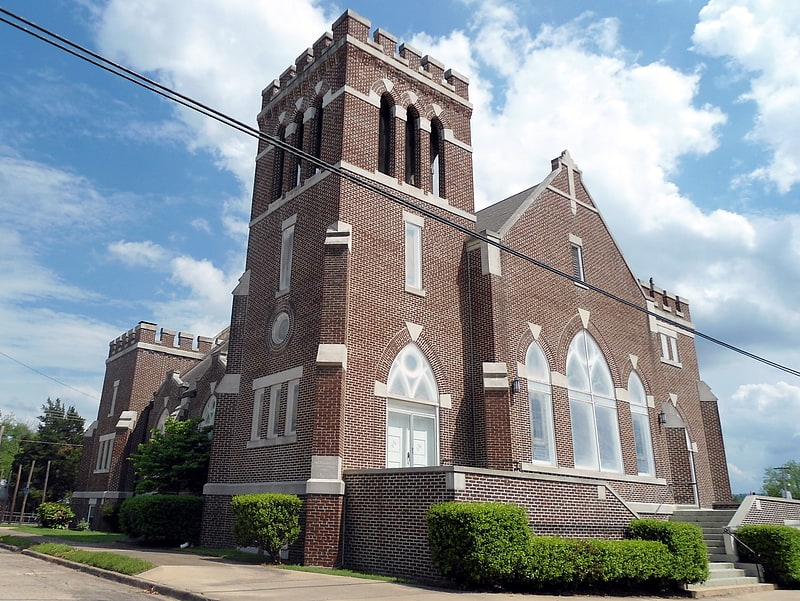
Church. The First United Methodist Church, originally the Methodist Episcopal Church, South is a historic church building at 205 North Elm Street in Paris, Arkansas. It is a two-story brick building with Late Gothic Revival styling, built between 1917 and 1928 for a congregation founded in the early 1870s. It is the congregation's fourth sanctuary, its first three having succumbed to fire. It has a gabled roof with corner sections and a tower topped by crenellated parapets.
The church was listed on the National Register of Historic Places in 1995.[4]
Short Mountain Creek Bridge

Bridge. The Short Mountain Creek Bridge carries Short Mountain Road across Short Mountain Creek, northwest of Paris, Arkansas. It is a single-span Parker pony truss bridge, with a span measuring 92 feet and a total structure length of 93 feet. It has a deck surface of concrete that is 21.7 feet wide. It was built in 1928 by the Virginia Bridge Company of Tennessee, and is the only bridge of this type in the area.
The bridge was listed on the National Register of Historic Places in 2004.[5]
Evelyn Gill Walker House
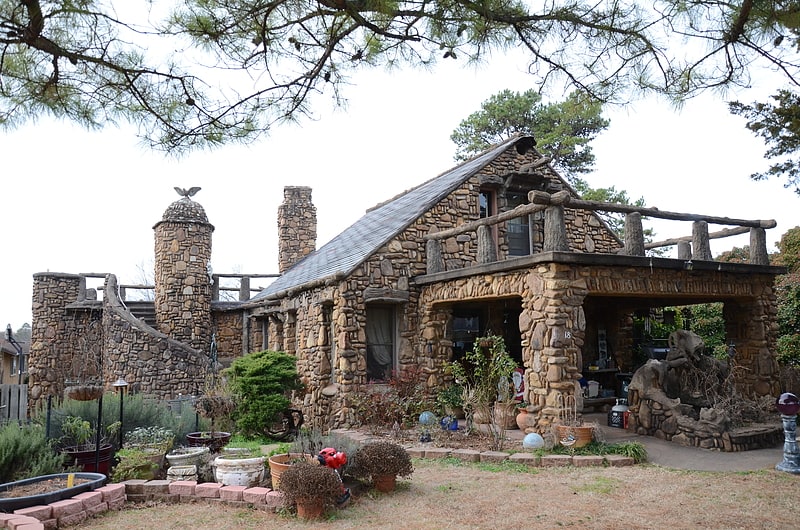
The Evelyn Gill Walker House is a historic house at 18 South Spruce Street in Paris, Arkansas. Built by mason Tolbert E. Gill over a several-year period beginning in 1938, it is a distinctive example of Gill's Rustic style, with a stone veneer exterior and decorative components. It has a 1+1⁄2-story gabled main section, with a flat-roof porch in front, and a flat-roof ell in the rear. The ell features a turret with a bell-cast top, with a surrounding curved staircase leading to an open deck on the ell's roof.
The house was listed on the National Register of Historic Places in 1993.[6]
Tolbert E. Gill House

The Tolbert E. Gill House is a historic house on the west side of South Spruce Street, just south of Arkansas Highway 22 in Paris, Arkansas. It is a single-story masonry structure, built of out rusticated stone by its first owner, stonemason Tolbert E. Gill. It is an architecturally unique and distinctive structure, with arched openings topped by castellated parapets. The yard is further adorned with stone artwork created by Gill, who is believed to be either a German immigrant or the son of German immigrants. Construction on the house began in 1920, and took about 15 years to achieve its present configuration.
The house was listed on the National Register of Historic Places in 1993.[7]
Paris Post Office
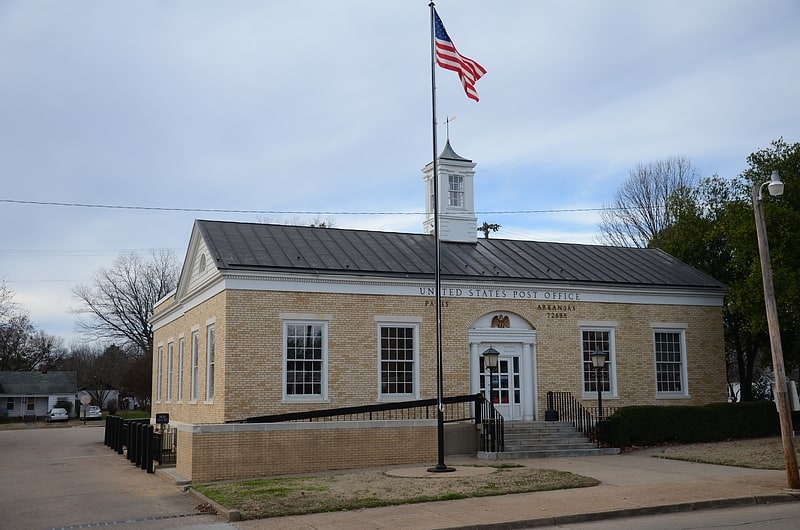
Building in Paris, Arkansas. The Paris Post Office is located at 206 North Elm Street in downtown Paris, Arkansas. It is located in a modest Colonial Revival building, built in 1937 as part of a major federal building project. It is notable for the controversy over its interior artwork, which was funded by the Treasury Department's Treasury Section of Fine Arts, and executed by Joseph P. Vorst. The murals proposed by Vorst depicted a raggedly dressed African-American with several skinny mules, approaching a tarpaper shack that appears to be the man's home. There was public outcry, with Vorst defending the depiction as an accurate rendition of the area during a visit he made. He then submitted an alternate drawing, which showed a stock farm, cotton gin, and other more benign imagery, which was accepted.
The building was listed on the National Register of Historic Places in 1998.[8]
Union Church and School
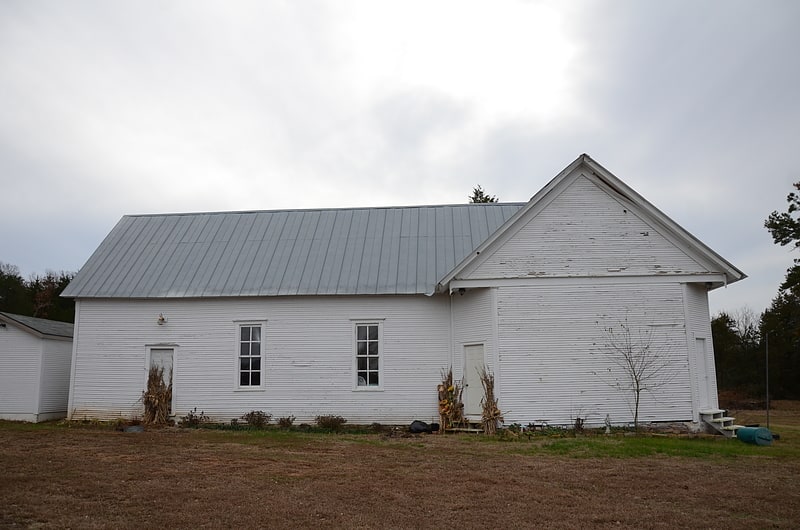
The Union Church and School is a historic combination church and school in rural Logan County, Arkansas. It is located northeast of Paris, on the south side of Union Road at its junction with Clayton Lane. It is a vernacular single-story L-shaped wood-frame structure, with a gabled roof, weatherboard siding, and a stone foundation. The right side of the building, a cross-gable section, was built about 1895, and the left portion was built about 1922. It served the surrounding community as a two-room school until 1948, and as a Presbyterian church until 1958.
The building was listed on the National Register of Historic Places in 2005.[9]
Old Logan County Jail
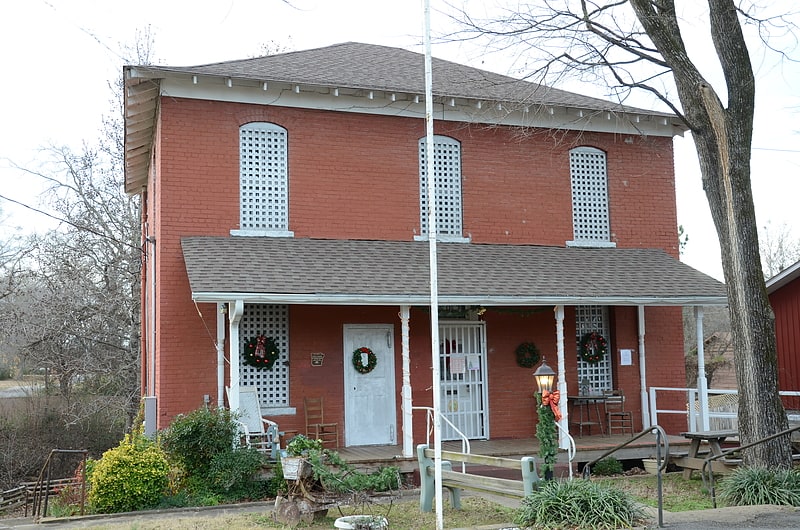
The Old Logan County Jail is a historic government building at 202 North Vine Street in Paris, Arkansas. It is a two-story brick building, covered by a hip roof with exposed rafter ends. Its main facade has a single-story porch extending across the front. Windows are set in segmented-arch openings, with strap-metal bars set across them in a crosshatch pattern. There are two entrances, one for the jailer's quarters, and one with bars that provides access to the cell block. Built in 1903, it is one of the state's best-preserved early 20th-century county jails. It is the site of the last legal hanging in Arkansas, which took place when John Arthur Tillman, 23, was hung on July 15, 1914, at 7 am for the murder of Amanda Jane Stephens, 19.
The jail was listed on the National Register of Historic Places in 1993.[10]
American Legion Post No. 121 Building

The American Legion Post No. 121 is a historic social hall on Legion Hut Road in southern Paris, Arkansas. It is a single-story L-shaped structure, built out of notched logs on a stone foundation. The logs are painted brown, and are mortared with white cement. It has a gabled roof with exposed rafter ends. A gabled porch shelters the front entrance, supported by square posts set on concrete piers faced in stone. The building was constructed in 1934 with work crews funded by the Works Progress Administration, and is the best local example of WPA Rustic architecture.
The building was listed on the National Register of Historic Places in 1995.[11]